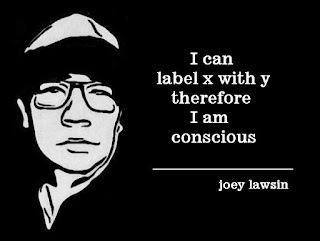The Simplified Definition of Consciousness
 What is Consciousness?
What is Consciousness?Is to be aware really means to be conscious?
In his works on I.M., Joey Lawsin coined the catchphrase "the Human Mental Handicap", or the Human Boundaries, in an attempt to define consciousness in its simplified form. He claimed that "No Human can ever think of a thing without labeling or matching such thought with something like an object, a word, a description, or definition." This measure of comparative learning by labeling, tagging, or one-to-one correspondence is technically known as Associative Consciousness.
In his book, Evolution of Creation, Lawsin defined Consciousness as more of Recognition than Awareness. He made it clear that Recognition is totally different from Awareness due to the fact that awareness is more of sensory simulation while recognition is more of associative connections.
Like for example, a newborn baby may react with his environment, but this doesn't mean that the baby is conscious. In other words, the baby is simply aware but not cognizant. He mechanically interacts with his surrounding but recognizes nothing including his self and his environment. Like an artificial sentient robot, the baby simply interacts with the environment through his biological sensors that stimulate awareness but knows nothing about himself and what these things are that surround him. He is simply self-animated by his sensors!
Plants are also aware because they interact with their surroundings. However, they are conscious as well. Since plants can hear, smell, feel, and remember their surroundings, according to a scientific study, then it shows that they have the potential to associate what they sense with other objects. This is a form of Recognition. Thus, if they feel warm, then they can differentiate hotness and coldness. If they react to sounds, then they can differentiate noise from music. If they can do this one to one correspondence, which is the ability to match one thing with another thing, then plants are conscious beings.
Animals are conscious beings as well. Although some of them are without brains, like the sea anemones, sea squirts, and many sea creatures, they are conscious beings because of their abilities to match things with other objects like the ability to change skin colors or hide during an enemy attack. Other animals like dogs use objects like bowls, balls, and bones and pair them with human words like food, play, and walk. Their skills to associate mental images with physical objects just show that dogs are conscious beings. (The Bowlingual Experiment, Lawsin 1988)
Lawsin also defined consciousness in a simple equation: He suggested that "If x is conscious with y then x is conscious, else, if x is by itself alone, then x is not conscious. In other words, he said: " If I am conscious with my dog then I am conscious. If I exist alone, by myself, without my dog and anyone else surrounding me, then I will never become conscious." Consciousness is made up of two basic elements: X and Y. If one of the two variables is missing, then consciousness is not present. Thus, to be conscious one must be aware of oneself and one's surroundings, from wherein this case, the surrounding is another person.
Therefore, to become conscious, two things must be present: a being and a surrounding or, a being and another being. (Definition-3, Lawsin 1988).
Intuitive Machines™ Biotronics™ Zoikrons™ Autognorics™ ELFS™ IM™
are original trademarks and logos
solely distributed by
L.A.W.S.I.N.
==============================
Comments
Post a Comment